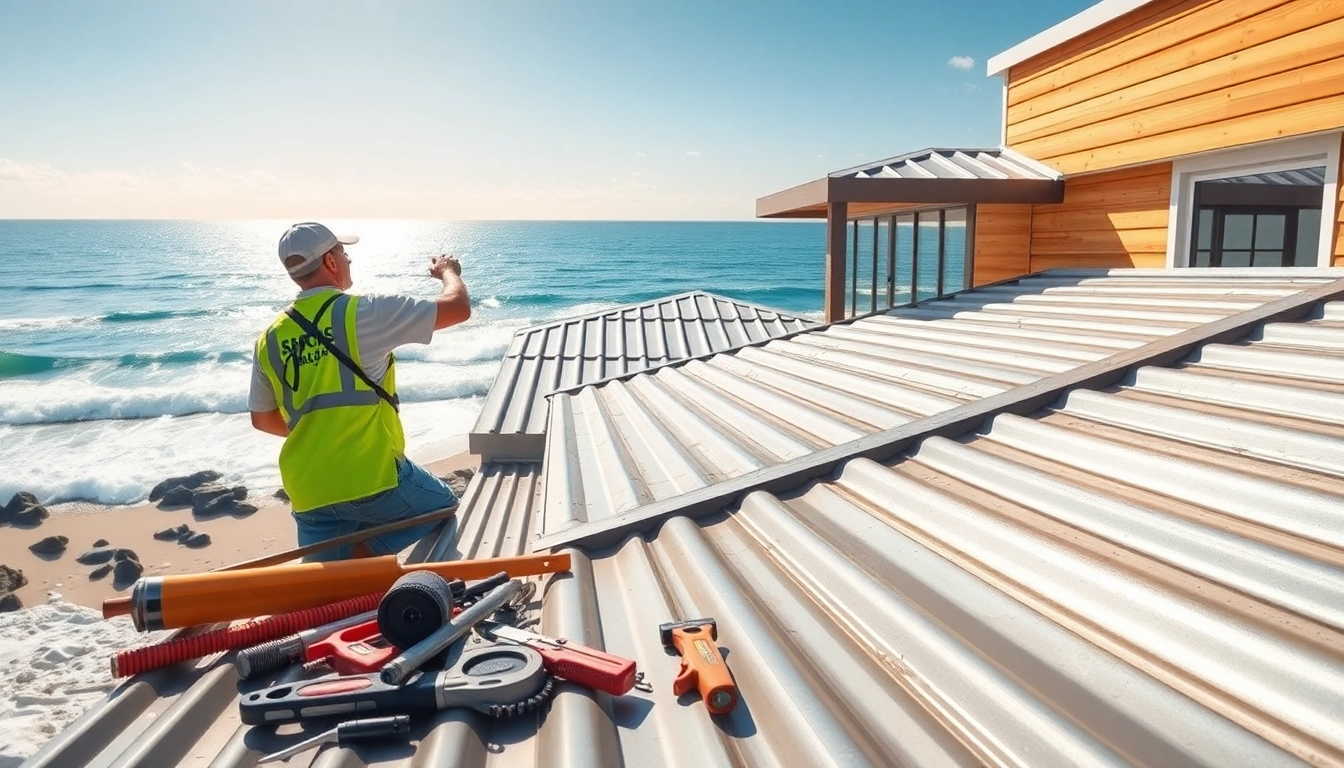
Understanding Coastal Metal Roofing
What is Coastal Metal Roofing?
Coastal metal roofing refers to a specialized kind of roofing system specifically designed to withstand the unique challenges posed by coastal environments. These challenges include intense humidity, salt spray, hurricane conditions, and fluctuating temperatures. Typically made from materials like steel, aluminum, or zinc, coastal metal roofing is recognized for its durability, longevity, and aesthetic versatility. Unlike conventional roofing materials, coastal metal roofs are engineered to resist corrosion and degradation caused by airborne salt and moisture, making them an ideal choice for homeowners along the coastline.
In many coastal regions, homeowners are increasingly turning to coastal metal roofing for its superior performance compared to traditional roofing options. These roofs not only provide structural integrity but also enhance the visual appeal of coastal properties, reflecting the beauty of their surroundings.
Benefits of Metal Roofing in Coastal Areas
Choosing metal roofing for coastal areas brings several advantages that make it an optimal choice for homeowners:
- Durability: Coastal metal roofs are highly resistant to harsh weather conditions, such as high winds and heavy rainfall. Their robust construction ensures longevity, often lasting 40 years or more with proper maintenance.
- Corrosion Resistance: Many coastal metal roofs are coated with materials that offer exceptional resistance to salt-based corrosion, a critical feature in coastal areas where salt spray can erode other roofing materials.
- Energy Efficiency: Metal roofs can significantly reduce energy consumption by reflecting solar radiant heat, which can help keep homes cooler in hot months, lowering air conditioning needs.
- Low Maintenance: With their resilience to elemental damage, metal roofs require less frequent repairs and maintenance compared to traditional roofing materials, making them a cost-effective solution in the long run.
- Aesthetic Variety: Metal roofing systems are available in diverse styles, colors, and finishes, allowing homeowners to enhance their property’s curb appeal while maintaining functionality.
Common Materials Used in Coastal Metal Roofing
Popular materials for coastal metal roofing include:
- Aluminum: Known for its lightweight properties and natural resistance to corrosion, aluminum is a popular choice for coastal metal roofing. Its ability to withstand salt and moisture makes it ideal for seaside installations.
- Galvalume Steel: This type of steel is coated with a mixture of aluminum and zinc, providing excellent corrosion resistance while maintaining strength. It’s particularly effective in areas with high salt exposure.
- Copper: While more expensive, copper roofs are renowned for their beautiful patina that develops over time. They also offer robust durability against coastal conditions and have a long lifespan.
- Zinc: Like copper, zinc is another premium material that develops a protective patina, enhancing its corrosion resistance. Zinc roofs can last well over 80 years with proper care.
Choosing the Right Type of Coastal Metal Roofing
Different Styles of Coastal Metal Roofing
There are various styles of coastal metal roofing to consider, including:
- Standing Seam: A popular choice for its clean lines and modern appearance. Standing seam roofs are characterized by vertical metal panels with raised seams that interlock, providing excellent water drainage and wind resistance.
- Metal Shingles: These offer the aesthetic appeal of traditional shingles with the durability of metal. They are available in various styles and colors, making them adaptable to a range of architectural designs.
- Corrugated Metal: Known for its wavy pattern, corrugated metal is one of the most economical options. It’s lightweight and relatively easy to install, making it suitable for both residential and commercial properties.
- Metal Tiles: Mimicking traditional roofing materials like tile or slate, metal tiles provide the same classic aesthetic while delivering the benefits of metal. These roofs offer exceptional longevity and resistance to storms.
Factors to Consider for Coastal Metal Roofing
When selecting coastal metal roofing, homeowners should take the following factors into account:
- Climate Resistance: Choose materials specifically designed to withstand coastal conditions, focusing on corrosion resistance and the ability to handle high winds.
- Local Building Codes: Check local regulations to ensure the selected roofing material meets the legal requirements for coastal building.
- Color and Reflectivity: Lighter colors can enhance energy efficiency by reflecting sunlight, while darker colors may absorb heat, contributing to higher cooling costs.
- Installation Requirements: Consider the complexity and expertise required for installation. Opting for a professional installer can ensure proper setup and longevity of the roofing system.
Cost Comparison of Coastal Metal Roofing Solutions
Cost is always a factor in choosing a roofing solution. While metal roofing can be more expensive upfront compared to traditional materials like shingles, it tends to save money over time due to its longevity and low maintenance requirements. Below is a brief cost comparison of different coastal metal roofing options:
- Aluminum Roofing: Typically ranges between $7.00 to $14.00 per square foot.
- Galvalume Steel Roofing: Approximately $5.00 to $11.00 per square foot, depending on gauge and finish.
- Copper Roofing: May range from $15.00 to $30.00 per square foot, reflecting its premium status.
- Zinc Roofing: Falls in a similar range to copper, ranging from $10.00 to $25.00 per square foot.
Installation Process for Coastal Metal Roofing
Steps to Install Coastal Metal Roofing
The installation of coastal metal roofing involves several key steps:
- Preparation: Prepare the roofing structure by ensuring that the underlying deck is clean, dry, and structurally sound. Repair any damages before proceeding.
- Underlayment Installation: Install a suitable underlayment to enhance water resistance and protect against ice damming and condensation buildup.
- Panel Measurement and Cutting: Carefully measure and cut metal panels to fit the specific roof dimensions. Use precise measurements to ensure a snug fit between panels.
- Panel Installation: Begin attaching the metal panels, starting from the eave of the roof and working upward. Secure them using the appropriate fasteners and overlap the joints as prescribed.
- Finishing Touches: Install flashings, trim pieces, and any decorative elements to ensure a finished look and added protection against water intrusion.
DIY vs. Professional Installation
While some homeowners may consider a DIY approach to install coastal metal roofing, there are significant advantages to hiring professionals:
- Experience: Professional installers have the expertise and training to handle the nuances of metal roofing, ensuring proper installation and adherence to safety standards.
- Warranty Protections: Many professional installations come with warranty coverage, providing peace of mind regarding the integrity of the roofing system.
- Efficiency: Professionals can complete the installation more quickly and effectively, minimizing the risk of mistakes that could lead to costly repairs later on.
Ultimately, while a DIY project might save initial costs, the risk of improper installation can lead to more significant expenses in the future. Weighing the pros and cons should lead homeowners to make an informed decision.
Tips for Ensuring Proper Installation
To ensure a successful coastal metal roofing installation, follow these best practices:
- Always use high-quality materials specifically designed for coastal conditions.
- Hire a reputable contractor with experience in metal roofing installations.
- Follow the manufacturer’s installation guidelines carefully to avoid voiding warranties.
- Check local building codes and obtain any necessary permits before starting work.
Maintenance Tips for Coastal Metal Roofing
Regular Maintenance Tasks for Longevity
To maximize the lifespan of your coastal metal roof, regular maintenance is essential. Here are some tasks to incorporate into your routine:
- Inspect Frequently: Perform visual inspections of the roof and flashing at least twice a year, especially after severe weather events.
- Clean the Roof: Remove debris such as leaves, branches, and other materials that can trap moisture and promote corrosion.
- Check Fasteners: Verify that all screws and fasteners are tight. Over time, some may loosen due to thermal expansion and contraction.
- Maintain Drainage Systems: Ensure gutters and downspouts are functioning correctly and free from blockages to prevent water pooling.
Signs Your Coastal Metal Roof Needs Repair
Being vigilant about potential issues can save homeowners significant time and money. Watch for the following signs that may indicate your coastal metal roof requires repairs:
- Visible rust or corrosion spots on the surface.
- Loose or missing panels, shingles, or fasteners.
- leaks or water stains appearing on ceilings or walls inside the home.
- Increased energy bills due to inadequate insulation or thermal resistance.
Seasonal Maintenance Checklist
To effectively maintain a coastal metal roof throughout the year, consider these seasonal tasks:
Spring
- Inspect for damage from winter storms.
- Clear gutters and downspouts of debris to ensure proper drainage.
Summer
- Check for signs of rust or corrosion due to increased humidity.
- Inspect sealing around vents and chimneys to prevent leaks.
Fall
- Remove leaves and branches that can accumulate on the roof.
- Inspect panels for any signs of loose fasteners or panels.
Winter
- Ensure that snow does not accumulate on the roof, as excessive weight can cause damage.
- Inspect insulation to ensure proper thermal resistance during colder months.
Case Studies: Successful Coastal Metal Roofing Projects
Residential Projects: Transforming Homes with Coastal Metal Roofing
Many homeowners along the coast have successfully transitioned to metal roofing. For instance, a family in Florida replaced their traditional shingle roof with a standing seam aluminum roof. This not only improved the aesthetic appeal of their beach home but also provided stronger wind resistance during hurricane season. Energy costs were reduced significantly, proving the investment worthwhile.
Commercial Use Cases in Coastal Environments
Commercial buildings, such as resorts and beachside restaurants, have also benefitted from coastal metal roofing. A case study in a popular tourist area highlighted how a zinc-coated roofing system enhanced the building’s resilience against saltwater exposure while blending seamlessly with the coastal landscape. This project received accolades not only for its functionality but also for its contribution to local architectural beauty.
Customer Testimonials and Feedback
Customer feedback highlights significant satisfaction with coastal metal roofing. Many have noted improvements in energy efficiency and reduced maintenance time. One homeowner mentioned, “Switching to metal roofing transformed my coastal home. I no longer worry about the roof during storms, and I love how it looks.” These testimonials reflect a growing trend towards investing in quality roofing solutions that are built to last.





